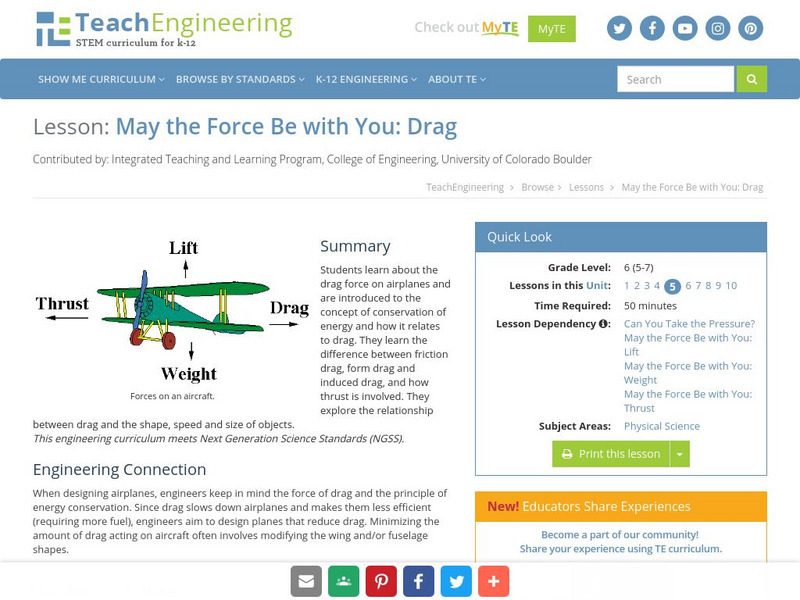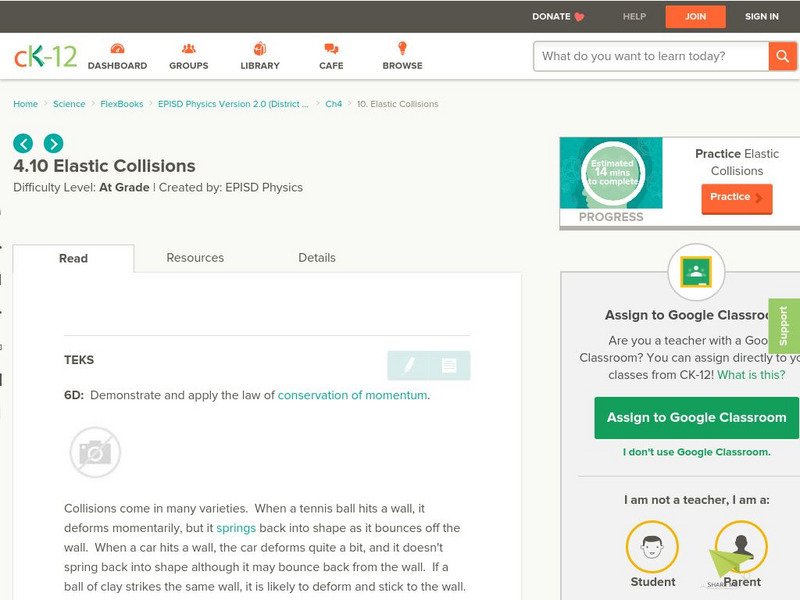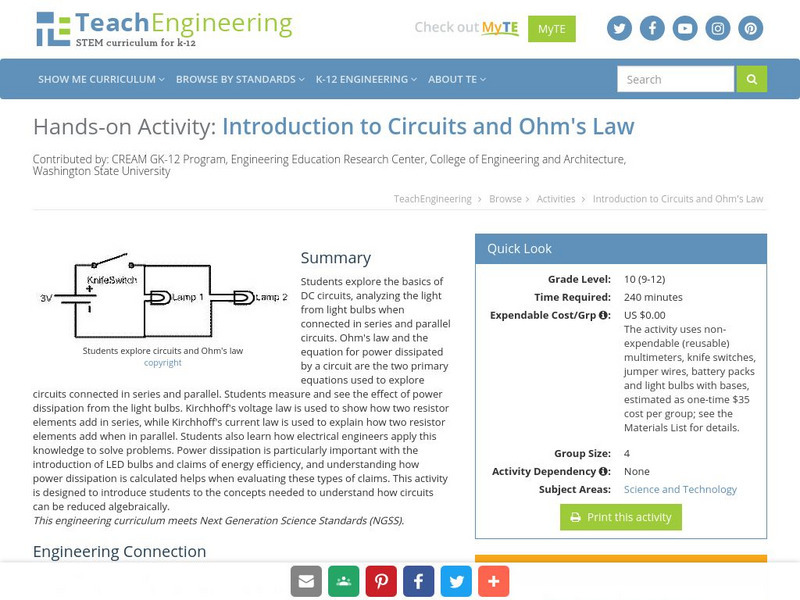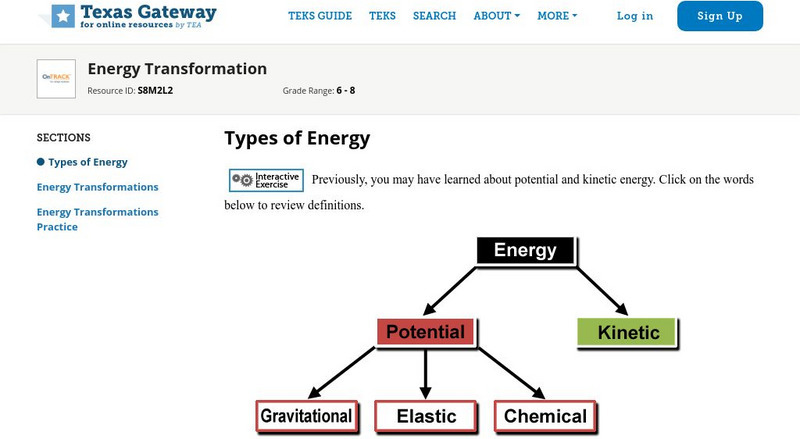Hi, what do you want to do?
TeachEngineering
Teach Engineering: May the Force Be With You: Drag
This instructional activity explores the drag force on airplanes. The students will be introduced to the concept of conservation of energy and how it relates to drag. Students will explore the relationship between drag and the shape,...
US Environmental Protection Agency
Epa: Conservation
Official site with information and resources relating to all aspects of environmental conservation: data, maps and laws. Specific environmental information by zip code provides immediate relevance to your world.
CK-12 Foundation
Ck 12: Elastic Collisions
[Free Registration/Login may be required to access all resource tools.] In this online tutorial students are asked to demonstrate and apply the law of conservation of momentum.
TeachEngineering
Teach Engineering: Introduction to Circuits and Ohm's Law
Students will explore the basics of dc circuits analyzing the light from light bulbs when connected in series and parallel circuits. Ohm's Law and the equation for power dissipated by a circuit will be the primary equations used. Using...
Physics Classroom
The Physics Classroom: Work and Energy: Energy Transformation on Roller Coasters
Using a roller coaster as an example, the transformation of mechanical energy from the form of potential to the form of kinetic and vice versa is explained and illustrated in the animation.
CK-12 Foundation
Ck 12: Earth Science: Introduction to Energy Resources Study Guide
This comprehensive study guide covers the main terms and concepts needed for an earth science unit on energy resources. Review questions are included at the bottom of the study guide.
CK-12 Foundation
Ck 12: Energy and Its Forms
[Free Registration/Login may be required to access all resource tools.] Students explore the different forms of energy and investigate how the law of conservation of energy plays an important part of those forms.
Physics Aviary
Physics Aviary: Energy Loss Lab
This lab is designed to have students investigate the amount of energy lost by a ball when it bounces. Students will change the starting height of the ball and see how this affects the amount of energy lost and the percent of the...
Science Struck
Science Struck: 22 Examples of Mechanical Energy
Explains what mechanical energy is and provides 22 examples of it.
Physics Aviary
Physics Aviary: Guided Energy Loss Lab
This guided lab is designed to have students investigate the amount of energy lost by a ball when it bounces. This guided activity is meant to be used as a pre-lab for students who will do this lab live. Students will get a certificate...
Alabama Learning Exchange
Alex: Transform Me! Types of Energy
Students will understand the law of conservation of energy and the transformation of energy from one type to another.
Other
Laws of Thermodynamics
A page from the Fundamentals of Physical Geography site. Identifies, describes and elaborates upon the first, second, and third laws of thermodynamics.
Georgia State University
Georgia State University: Hyper Physics: First Law of Thermodynamics
At this site from Georgia State University the first law of thermodynamics is stated and explained. The meaning of internal energy and enthalpy is discussed. Equations are given and the importance of a system analysis is discussed.
Estrella Mountain Community College
Online Biology Book: Laws of Thermodynamics
Find out about the first and second laws of thermodynamics, and how they relate to the biology of life.
NASA
Nasa: Kepler's Second Law
This site from NASA states Kepler's second law of planetary motion and depicts its meaning with an informative diagram. Relates the law to conservation of energy principles and discusses the eccentricity of a satellite's (or a planet's)...
Physics Classroom
The Physics Classroom: Energy Conservation on an Incline
This site is a discussion and animation about whether the total mechanical energy of a cart rolling down an incline is conserved, which can be determined if there are any external forces acting upon it.
Physics Classroom
The Physics Classroom: Work, Energy, and Power: Mechanical Energy Is Conserved
In this interactive exercise, explore the quantitative relationship between work and mechanical energy in situations in which there are no external forces doing work.
FT Exploring
Ft Exploring: Energy Conversions: Potential to Kinetic Energy
Find out how gravitational potential energy is converted to kinetic energy, then finally into low-grade thermal energy.
Texas Education Agency
Texas Gateway: Energy Transformation
Given descriptions, illustrations, or scenarios, students will identify energy transformations, such as how energy in a flashlight battery changes from chemical energy to electric energy to light energy.
Physics Classroom
The Physics Classroom: Work, Energy, and Power: Application/practice Questions
Through illustrated examples and practice problems, students apply the relationship between work and mechanical energy change to a variety of motion scenarios in order to test our understanding.
Physics Classroom
The Physics Classroom: Work and Energy: Energy Transformation for a Dart
Consider an ordinary dart projected from a toy dart gun and moving through the air. Students analyze work and energy of the motion of the dart with this animation.
TeachEngineering
Teach Engineering: How a Hybrid Works
In Lesson 4, students conclude the Research and Revise step of the Legacy Cycle, as they investigate different forms of hybrid engines as well as briefly conclude a look at the different forms of potential energy. Students apply basic...
University Corporation for Atmospheric Research
Ucar: Earth's Energy Balance
See how Earth's temperature would change if the Sun's brightness increased or dimmed or if Earth's albedo was different.
CK-12 Foundation
Ck 12 Exploration Series: Simulations: Physics: Ballistics Tests
[Free Registration/Login Required] Practice with the concepts of conservation of momentum and energy by analyzing a special case of the ballistic pendulum.


















